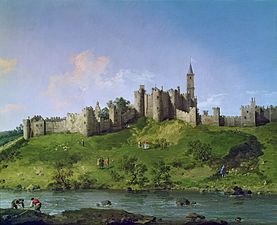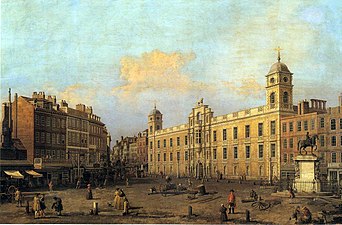Canaletto
Canaletto, whose real name was Giovanni Antonio Canal (Venice, October 18, 1697 - Venice, April 19, 1768), was an Italian painter. famous for his urban landscapes of Venice within the new genre of the veduta. Son of the painter Bernardo Canal, he took the name Canaletto to distinguish himself from him; His nephew Bernardo Bellotto occasionally used the same pseudonym Canaletto in his own career.
Biography
Early days
Canaletto was born in Venice, Republic of Venice into a family formed by Bernardo and Artemisia Barbieri. In 1716 at the age of 19 he begins to work as an apprentice to his father along with his brother. His father, Bernardo, worked as a theatrical set designer in which he painted large sets for performances. Under this early influence, the artist began to become familiar with large urban landscapes while he began to study with Luca Carlevarijs, a painter of street scenes. and is also influenced by another painter Marco Ricci
Three years after starting to work with his father, in 1719, Canaletto travels with Bernardo Canal to Rome to paint the decorations for Scarlatti's operas for a year. This trip will prove crucial in his life since that on this trip he got to know the work of Giovanni Paolo Pannini, a great painter of the time, a follower of the Vedutista current, specialized in large landscapes and classical ruins. During his stay in Rome, he interacted with different landscape artists and began to paint urban scenes.
After completing his work in Rome, he returned to Venice in 1720 and registered with the Venetian painters' guild to which he would belong until 1767. At this time, Canaletto's pictorial technique focused on strong contrasts of light, as well as on a direct technique without the use of previous preparatory sketches for the final painting. His technique also includes finishing the work in situ and not inside the studio as was customary at that time, using the camera obscura for framing the landscapes, as well as like a thick brushstroke that gives the painting a sensation of humidity.(Work)
His first works date from the 1720s to 1730s. His first dated and signed work that is known today appears in 1723, "Capriccio Arquitectónico" (1723, Milan, private collection), Capriccio Arquitéctónico , thus receiving his first commissions from Stefano Conti and the Prince of Liechtenstein. At that time he began to establish a friendship with what would be his biggest client, patron and ambassador of his work, Joseph Smith, English consul in the Republic of Venice. The works of this period are considered by many to be the best as The Stonemason's Yard (1729, London, National Gallery).
Between 1740 and 1741 he made a trip along the Brenta River during which he created numerous paintings. In the 1740s he began to vary his technique and began to use loose, imprecise brushwork. His colors are no longer dark and he begins with the use of light, gold, red and other bright colors that give the painting great luminosity.(Work)
English period
In 1746 Canaletto moved to England to work in that country until his return to Venice in 1755. His move to England had been forced in part by the war of the Austrian succession that made English visitors, Canaletto's main clients, who bought his paintings as souvenirs within the so-called Grand Tour, did not visit Venice.
Final stage of his life
After returning to Venice in 1756, he was made a member of the Venetian Academy of Painting and Sculpture in 1763. The technique of his later years is characterized by an undeveloped, superficial style and systematic repetition of landscapes. His remains rest in Venice.
Popularity
His recognition spread through his work and the generation of disciples he trained, including Bernardo Belloto, Francesco Guardi, Michele Marieschi, Gabriele Bella and Giuseppe Bernardino Bison.
Joseph Smith sold a large part of his collection to King George III who included it in the Royal Collection. Thanks to his trip, stay and sale of paintings in Venice, many of his paintings are in England in museums and private collections such as the Wallace Collection, the Soane Museum or the Woburn Abbey palace.
During the XIX century, Canaletto's esteem declined, and he was harshly criticized by Ruskin. It rose to prominence indirectly thanks to the Venetian views painted by Claude Monet and later painters. In 2005, at the auction held at Sotheby's in July, the painting Grand Canal, View North East from Palazzo Balbi towards the Rialto Bridge fetched £19 million.
Work
Canaletto's work consists of 116 pieces, which can be divided into landscapes and views (86), customs and history (1), interiors (3), and drawings and engravings (26).
Gallery
Landscapes and views
Early times (1720-1729)
- 1720-1725
These works are carried out upon his return from his stay in Rome. In 1723 he is commissioned by a Venetian nobleman to paint four canvases with views of the city of Venice, probably to decorate his palace. These four paintings constitute the beginning of the veduta style in the artist. Two of these four paintings are preserved in the Museo del Settecento Veneziano (Venice) and two in the Thyssen-Bornemisza Museum (Madrid). At this time stand out:
- Grand Canal, view northeast from the Balbi Palazo towards the Rialto Bridge (1723-24) Oil on canvas, 144 x 207 cm. Museo del Settecento Veneziano, Ca' Rezzonico, Venice.
- Grand Canal, East View from San Vio Field (1723-24), Oil on canvas, 140.5 x 204,5 cm. Thyssen-Bornemisza Museum, Madrid.
- 1725-1729
In 1725 Canaletto meets the businessman Owen McSwiney and the art dealer and English consul in Venice Joseph Smith. McSwiney, tells him about his idea of making landscape paintings to decorate the mansions of the English nobles who visited Venice during the Grand Tour. A short time later, Smith relieves McSwiney of this task and becomes his main dealer.
Splendor (1730-1746)
During these three decades the painter lived his best creative period. The visions of Venice and the paintings that reflect events of life in the duchy stand out.
- 1730-1731;
- Piazza San Marco with the Basilica (1730), Oil on canvas, 76 x 114,5 cm. Fogg Art Museum, Cambridge.
- Piazza San Marco (1730), Oil on canvas, 68.6 x 112.4 cm. Metropolitan Museum of Art, New York.
- The Bucintoro returns to Molo on Ascension Day (1730), Oil on canvas, 182 x 259 cm., Private Collection.
- 1732-1734
- Grand Canal: From Santa Maria della Carità to Bacino di San Marco (1730-33), Oil on canvas, 47.9 x 80 cm. Royal Collection, Windsor.
- A Regatta on the Grand Canal (1732), Oil on canvas, 77 x 126 cm. Royal Collection, Windsor.
- The Piazzetta (1733-35), Oil on canvas, 68.6 x 91.5 cm. Galleria Nazionale d'Arte Antica, Rome.
- Venice view from San Giorgio Maggiore (173?), Oil on canvas, 77 x 97 cm. Städel Institute, Frankfurt
- 1735-1739
- The party of San Roque (1735), Oil on canvas, 147.5 x 199,5 cm. National Gallery, London.
- Regatta on the Grand Canal (after 1735), Oil on canvas, 117 x 186 cm. National Gallery, London.
- Bacino di San Marco (1738-40), Oil on canvas, 125 x 204 cm. Boston Museum of Fine Arts, Boston.
- 1740-1746
- The Bucintoro returns to Molo on Ascension Day (1740), Oil on canvas, 187 x 259 cm. Pushkin Museum, Moscow.
- Entrance to the Grand Canal: East View (1744), Oil on canvas, 127 x 203 cm. Royal Collection, Windsor.
- Capriccio: Palladino Design for the Rialto Bridge, with buildings and Vicenza (1740), Oil on canvas, 60.5 x 82 cm. National Gallery of Parma.
English period (1746-1754)
After leaving Venice, Canaletto heads to England, where most of his clients are. This period is the beginning of the problems and the decline of the artist. His technique becomes more automated and he begins to receive criticism from critics.
- London: the Old Horse Guards and Banqueting Hall, from St James's Park (1749), Oil on canvas, 45.5 x 76 cm. Private collection.
- London: Northumberland House (1752), Oil on canvas, 84 x 137 cm. Private collection.
- Old Bridge of Walton (1754), Oil on canvas, 48.8 x 76.7 cm. Dulwich Picture Gallery, London.
Final stage (1755-1768)
After the London disappointment, Canaletto returns to Venice where his technique becomes darker, with dark colors predominating.
- Scala dei Giganti (1765), Oil on canvas, 42 x 29 cm Private Collection, Mexico.
Customs
Only one painting of customs remains, the Study of Figures, Canvas. 41 x 58.5cm. Gemäldegalerie. Berlin. Germany.
Interiors
His interior work is scarce, only three paintings being preserved today:
- The interior of the Basilica (1760). Oil on canvas. 28 x 19 cm. Windsor, Windsor Castle, Royal Collection.
- 'San Marco: Interior (1755), Oil on canvas, 36.5 x 33.5 cm. Royal Collection, Windsor.
- Inside the Ranelagh House roundabout (1754). Oil on canvas. 46 x 75.5 cm. The National Gallery. London. England.
Drawings and engravings
Most of the engravings are preparatory works for later paintings, there is also a self-portrait.
Contenido relacionado
John Vincent Gomez
Robert Delaunay
Krzysztof Zanussi











![Il Bucintoro. Museo Thyssen-Bornemizsa en depósito en el Museo Nacional de Arte de Cataluña (MNAC)[13]](https://upload.wikimedia.org/wikipedia/commons/thumb/7/78/Canaletto_-_Return_of_%27Il_Bucintoro%27_on_Ascension_Day_-_Google_Art_Project.jpg/352px-Canaletto_-_Return_of_%27Il_Bucintoro%27_on_Ascension_Day_-_Google_Art_Project.jpg)
![Plaza de San Marcos en Venecia, hacia 1723-1724. Museo Thyssen-Bornemisza, Madrid. [14]](https://upload.wikimedia.org/wikipedia/commons/thumb/6/66/Canaletto_-_The_Piazza_San_Marco_in_Venice_-_Google_Art_Project.jpg/325px-Canaletto_-_The_Piazza_San_Marco_in_Venice_-_Google_Art_Project.jpg)